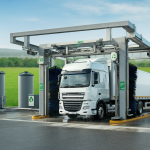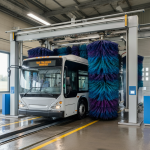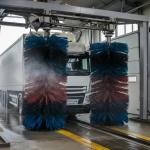Keeping a fleet of buses clean is not only essential for maintaining a professional image, but it also plays a significant role in ensuring operational efficiency and cost savings. Manual cleaning methods can be time-consuming and labor-intensive, requiring a dedicated team to wash each vehicle individually. This is where automatic bus washes step in to revolutionize fleet maintenance.
Automatic bus wash systems are designed to handle the unique requirements of cleaning buses efficiently and effectively. From removing dirt and grime to tackling larger vehicles’ surfaces, these wash systems offer a comprehensive cleaning solution that saves both time and money.
With automated systems, fleet operators can minimize the resources needed for manual cleaning, such as water, cleaning agents, and labor. By optimizing the cleaning process, automatic bus washes not only help in achieving efficiency but also contribute to cost savings in the long run.
Investing in automated bus wash systems enables fleet managers to streamline their maintenance operations, enhance the lifespan of their buses, and improve overall cleanliness. By incorporating these advanced technologies, fleet operators can not only maintain a pristine fleet appearance but also enjoy the benefits of increased productivity and reduced operational costs.
The importance of fleet maintenance in the transportation industry
Maintaining a well-functioning fleet of buses is crucial for the transportation industry. Buses are the backbone of public transportation, connecting communities and providing a vital service to millions of commuters worldwide. Efficient fleet management is essential for ensuring the reliability, safety, and longevity of these vehicles, which are subjected to constant use and exposure to various environmental factors.
Proper fleet maintenance not only keeps buses in optimal condition but also contributes to the overall success of transportation companies. Well-maintained buses experience fewer breakdowns, resulting in reduced downtime and improved service reliability. This, in turn, enhances customer satisfaction and helps to build a positive brand reputation, which is crucial in a highly competitive industry.
Furthermore, effective fleet maintenance can lead to significant cost savings. By proactively addressing maintenance needs, transportation companies can avoid costly repairs, extend the lifespan of their vehicles, and reduce fuel consumption. This financial optimization allows for more efficient resource allocation, enabling companies to invest in other areas of their business, such as fleet expansion, technology upgrades, or customer service improvements.
Common challenges in bus fleet maintenance
Maintaining a fleet of buses presents a unique set of challenges for transportation companies. The sheer size and complexity of these vehicles, combined with the demands of daily operations, can make fleet maintenance a daunting task.
One of the primary challenges is the time-consuming nature of manual cleaning methods. Washing each bus individually can be a laborious and time-consuming process, requiring a dedicated team of workers and significant resources, such as water, cleaning agents, and equipment. This manual approach can be inefficient, especially when dealing with a large fleet, and can lead to inconsistent cleaning results.
Another challenge is the need to maintain a professional appearance for the fleet. Buses are a highly visible representation of a transportation company, and their cleanliness and condition directly impact the company’s image and customer perception. Failure to keep buses clean and well-maintained can negatively affect the company’s reputation and public trust.
Additionally, the environmental impact of traditional cleaning methods is a growing concern. Excessive water usage, the disposal of wastewater, and the use of harsh chemicals can have a detrimental effect on the local ecosystem. Transportation companies must find ways to address these environmental concerns while still maintaining their fleet to the highest standards.

How automatic bus washes improve efficiency and cost savings
Automatic bus wash systems offer a comprehensive solution to the challenges faced by transportation companies in maintaining their fleets. These advanced systems are designed to streamline the cleaning process, resulting in increased efficiency and substantial cost savings.
One of the primary benefits of automatic bus washes is the significant reduction in labor requirements. Instead of relying on a team of manual workers to wash each bus individually, automatic systems can handle the cleaning process with minimal human intervention. This not only saves on labor costs but also frees up employees to focus on other essential tasks, such as routine maintenance or customer service.
Automatic bus washes also contribute to cost savings by optimizing the use of resources. These systems are designed to minimize water consumption, reduce the need for cleaning agents, and improve energy efficiency. By automating the cleaning process, transportation companies can achieve significant reductions in their operational expenses, which can be reinvested into other areas of the business.
Furthermore, automatic bus washes can help to extend the lifespan of buses by providing a more thorough and consistent cleaning. The advanced features of these systems, such as high-pressure sprayers, rotating brushes, and specialized detergents, can effectively remove dirt, grime, and other contaminants that can damage the bus’s exterior and interior over time. By maintaining the buses in optimal condition, transportation companies can reduce the frequency of costly repairs and replacements, leading to long-term cost savings.
Environmental benefits of automatic bus washes
In addition to the efficiency and cost-saving benefits, automatic bus wash systems also offer significant environmental advantages. As environmental concerns continue to grow, transportation companies are under increasing pressure to adopt more sustainable practices and reduce their carbon footprint.
Automatic bus washes are designed with environmental considerations in mind. These systems are engineered to minimize water consumption, with advanced water recycling and reclamation technologies that can reduce water usage by up to 80% compared to traditional manual washing methods. This not only saves a valuable natural resource but also reduces the strain on local water infrastructure and the associated costs.
Moreover, automatic bus washes utilize eco-friendly cleaning agents that are biodegradable and less harmful to the environment. These specialized detergents are formulated to effectively clean the buses while minimizing the impact on the surrounding ecosystem. This approach helps to reduce the release of harmful chemicals into the environment, contributing to a more sustainable transportation industry.
Another environmental benefit of automatic bus washes is the reduction in energy consumption. These systems are designed with energy-efficient components, such as high-performance motors and optimized water heating systems, which can significantly lower the overall energy usage compared to manual cleaning methods. This, in turn, leads to a smaller carbon footprint and aligns with the growing demand for environmentally conscious transportation solutions.
Choosing the right automatic bus wash system for your fleet
Selecting the appropriate automatic bus wash system for your transportation fleet is a crucial decision that can have a significant impact on the efficiency, cost savings, and environmental performance of your operations.
When evaluating automatic bus wash systems, it’s important to consider the unique requirements and characteristics of your fleet. Factors such as the size and configuration of your buses, the frequency of cleaning, and the available space for the installation of the system should all be taken into account.
One key consideration is the type of automatic bus wash system that best suits your needs. There are several options available, including in-bay automatic washes, which are self-contained units that can handle a single bus at a time, and tunnel-style washes, which are designed to accommodate multiple buses in a continuous cleaning process. The choice between these systems will depend on the size and layout of your facility, as well as the desired throughput and efficiency levels.
Additionally, it’s important to evaluate the features and capabilities of the automatic bus wash systems you’re considering. Look for systems that offer advanced cleaning technologies, such as high-pressure water jets, rotating brushes, and specialized detergents, to ensure a thorough and consistent cleaning. Consider the system’s water and energy efficiency, as well as its ease of maintenance and operation, to optimize your long-term cost savings and environmental impact.

Case studies: Success stories of fleet maintenance with automatic bus washes
To illustrate the real-world benefits of incorporating automatic bus washes into fleet maintenance, let’s explore a few case studies of transportation companies that have successfully implemented these systems.
One such example is the City of Los Angeles Department of Transportation (LADOT), which operates a large fleet of buses serving the city’s extensive public transportation network. Faced with the challenges of manual cleaning and the need to maintain a professional appearance, LADOT decided to invest in an automatic bus wash system. The implementation of the system resulted in significant improvements, including a 50% reduction in water usage, a 30% decrease in cleaning time, and a notable improvement in the overall cleanliness and appearance of the fleet.
Another success story comes from the New York City Transit Authority (NYCT), which oversees the largest public transportation system in North America. Recognizing the need to streamline their fleet maintenance operations, NYCT installed a state-of-the-art automatic bus wash system at one of their key maintenance facilities. The system’s advanced features, such as high-pressure water jets and specialized detergents, enabled NYCT to achieve a 25% reduction in water consumption and a 20% decrease in cleaning costs, all while maintaining a consistently clean and well-maintained fleet.
In a third case study, the Chicago Transit Authority (CTA) implemented an automatic bus wash system to address the challenges of manual cleaning and enhance the overall efficiency of their fleet maintenance. The CTA’s investment in this technology has resulted in a 40% reduction in labor costs, a 35% decrease in water usage, and a significant improvement in the appearance and condition of their buses, contributing to increased customer satisfaction and a stronger brand reputation.
These case studies demonstrate the tangible benefits that transportation companies can achieve by incorporating automatic bus wash systems into their fleet maintenance strategies. From improved efficiency and cost savings to enhanced environmental sustainability, the implementation of these advanced systems has proven to be a game-changer for leading transportation authorities across the United States.
Maintenance tips for automatic bus wash systems
Maintaining the optimal performance and longevity of an automatic bus wash system is crucial for transportation companies to continue reaping the benefits of this technology. Proper maintenance not only ensures the system’s reliability but also helps to maximize the return on investment and minimize the risk of costly breakdowns or repairs.
One of the key maintenance practices is regular inspections and preventive maintenance. Transportation companies should establish a comprehensive maintenance schedule that includes regular checks of the system’s components, such as the water pumps, motors, brushes, and detergent dispensers. By proactively addressing any issues or wear and tear, companies can avoid costly downtime and ensure the system’s continued efficiency.
Another important aspect of maintenance is the proper cleaning and care of the automatic bus wash system itself. This includes regularly flushing the water lines, cleaning the nozzles and spray bars, and maintaining the pH balance of the water to prevent the buildup of mineral deposits or corrosion. By keeping the system clean and well-maintained, transportation companies can extend the lifespan of their investment and minimize the need for major repairs or replacements.
Additionally, transportation companies should consider investing in ongoing training and education for their maintenance staff. Understanding the intricacies of the automatic bus wash system, including its operation, troubleshooting, and repair procedures, can empower the maintenance team to proactively address any issues and maintain the system at peak performance levels.
By implementing a comprehensive maintenance program, transportation companies can ensure the long-term reliability and efficiency of their automatic bus wash systems, ultimately contributing to the overall cost savings and operational success of their fleet management strategies.
The future of automatic bus wash technology
As the transportation industry continues to evolve, the future of automatic bus wash technology holds exciting prospects for fleet operators. Advancements in various areas, such as automation, data analytics, and sustainability, are poised to further enhance the efficiency, cost savings, and environmental benefits of these systems.
One emerging trend in automatic bus wash technology is the integration of advanced sensors and data analytics. By leveraging the power of IoT (Internet of Things) and Big Data, these systems can provide fleet managers with real-time insights into the cleaning process, water and energy usage, and equipment performance. This data can be used to optimize maintenance schedules, identify areas for improvement, and make informed decisions about system upgrades or replacements.
Another area of innovation is the development of more eco-friendly and sustainable automatic bus wash systems. Manufacturers are continuously working to improve water recycling and reclamation technologies, as well as exploring the use of alternative cleaning agents that are less harmful to the environment. These advancements will enable transportation companies to further reduce their environmental impact and align with the growing demand for sustainable transportation solutions.
Additionally, the integration of autonomous and robotic technologies into automatic bus wash systems may revolutionize the cleaning process. Automated systems capable of self-diagnosis, self-adjustment, and even self-cleaning could significantly enhance the efficiency and reliability of the cleaning operations, reducing the need for human intervention and further optimizing resource utilization.
As the transportation industry continues to evolve, the future of automatic bus wash technology promises a more efficient, cost-effective, and environmentally responsible approach to fleet maintenance. By staying informed about these advancements and embracing the latest innovations, transportation companies can position themselves at the forefront of the industry, reaping the benefits of enhanced operational efficiency and cost savings while contributing to a more sustainable transportation ecosystem.

Conclusion: The value of investing in automatic bus washes for fleet maintenance
In the transportation industry, the maintenance and upkeep of bus fleets are crucial for ensuring operational efficiency, cost savings, and environmental sustainability. Automatic bus wash systems have emerged as a game-changing solution, offering a comprehensive approach to fleet cleaning that addresses the common challenges faced by transportation companies.
By investing in automatic bus wash systems, transportation companies can enjoy a wide range of benefits, including reduced labor costs, optimized resource utilization, extended vehicle lifespan, and improved environmental performance. These advanced systems not only streamline the cleaning process but also contribute to the overall success and competitiveness of transportation businesses.
As the industry continues to evolve, the future of automatic bus wash technology promises even greater advancements, with the integration of data analytics, autonomous technologies, and sustainable practices. By staying ahead of these trends and embracing the latest innovations, transportation companies can position themselves as leaders in the industry, delivering exceptional service to their customers while contributing to a more environmentally responsible transportation ecosystem.
Ultimately, the investment in automatic bus wash systems represents a strategic decision that can yield long-term benefits for transportation companies. By prioritizing fleet maintenance and leveraging the power of this transformative technology, transportation companies can achieve greater efficiency, cost savings, and environmental stewardship – all of which are essential for thriving in the dynamic and competitive transportation landscape of the future.




